From start-ups to sprawling enterprises, headcount planning is a critical business initiative for companies of all shapes and sizes. As organizations grow, it’s imperative to have the right hiring plans in place to support corporate goals.
Headcount planning, otherwise known as workforce planning or org charting, is a key part in creating a successful recruitment strategy.
While it’s vital, it’s definitely not easy. And without robust tools and technology, headcount planning for recruitment can be a headache: from understanding team budgets and prioritizing DEI, to department-wide roadmapping, it’s a long and complicated process.
The good news is, modern business professionals don’t have to go about workforce planning alone. When it comes to creating a surefire recruitment strategy, software like ChartHop can help simplify your processes, so you can focus on what matters most: finding the right talent with the right skills for the right roles. Here’s how.
What is Headcount Planning Software?
Headcount planning software is technology designed to streamline the process of creating and implementing growth initiatives.
To reiterate, headcount planning is an essential part of business expansion. It goes beyond hiring people: workforce planning spans an entire organization and incorporates a multitude of company and talent management strategies, like budgeting, attrition and succession planning, product roadmapping, and more.
Traditionally, workforce planning is a painstaking process full of spreadsheets and pivot tables, disparate data, and other manual tactics. Now, software like ChartHop helps business leaders simplify these processes.
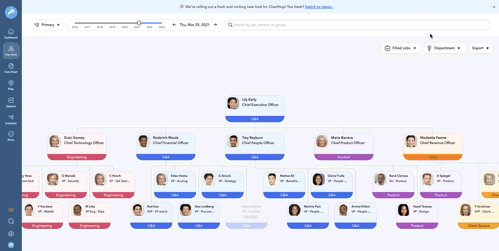
How? ChartHop visualizes a business’s structure in one, dynamic org chart that allows users to quickly see their entire organization in a single platform. When populated with rich people and company data, professionals can know their workforce inside and out — not just employee headcount, but demographics, skills, communication preferences, compensation packages, and more.
All of this is updated automatically via the platform’s robust data integrations, so users can stop using spreadsheets and disparate systems. Instead, everything they need lives in an up-to-date single source of truth that can be used to forecast headcount and plan for the future.
How Headcount Planning Software Elevates Your Recruitment Strategy
While headcount planning is a comprehensive initiative that affects all parts of a business, it can be especially useful for hiring. Here’s how technology like ChartHop can help take your recruitment strategy to the next level:
1. Centralize your current workforce data
Planning for the future starts with an in-depth understanding of the here and now. Especially when it comes to recruitment, knowing your current workforce inside and out helps inform hiring decisions down the line.
As we mentioned, headcount planning software like ChartHop allows you to collect and centralize all your people data in a single platform. This is key for hiring managers, recruiters, talent acquisition specialists, and functional leaders who rely on a holistic understanding of their current talent pool to fill hiring gaps.
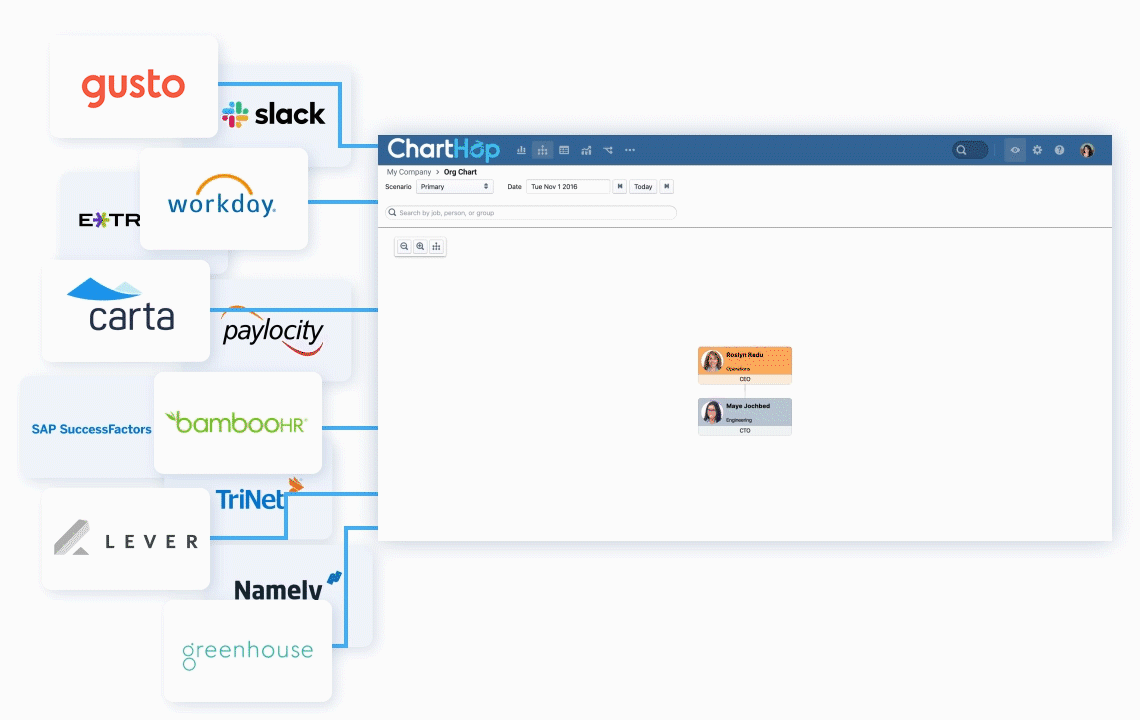
Traditional org charts only show reporting structures paired with names and titles. Now, technology like ChartHop integrates with applicant tracking systems, onboarding software, and other tools in your HR tech stack, so employee information is fed directly to the org chart. This data surpasses names and titles — with ChartHop, HR professionals can access a wealth of people data:
- Key demographics: like gender, ethnicity, race, and location.
- Role-specific intel: like core skills, communication preferences, and work specialities.
- Company data: like reporting structure, compensation and benefits, and training completion rates.
- Personal information: like pronouns, name pronunciation, and personalized “About Me” profiles.
With this knowledge, recruiters are armed to know exactly what roles they need to fill when headcount planning time comes around.
ChartHop allows for a time series view of our workforce and easily allows leaders to see how company resourcing needs change over time.
This allows me to forecast future headcount and spend changes. Additionally, it’s many integrations provide a holistic understanding of our workforce’s compensation and benefits in one centralized repository.
Weifang Zhu, SVP Growth & Operations @ Even Financial
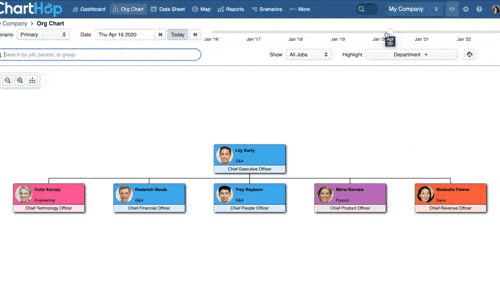
ChartHop also offers an interactive timeline feature that allows users to see how their company has evolved over time. By examining historical data, recruitment teams can see where they were weeks, months and years ago. An understanding of how the workforce has grown and where it currently stands empowers them to make better hiring decisions down the line.
2. Collaborate effortlessly
Headcount planning for hiring can be time-consuming and complicated. Between meetings with various stakeholders, establishing a budget, and agreeing on a timeline, successfully implementing a recruitment strategy involves a lot of moving parts. This makes having a platform that enables seamless collaboration all the more essential.
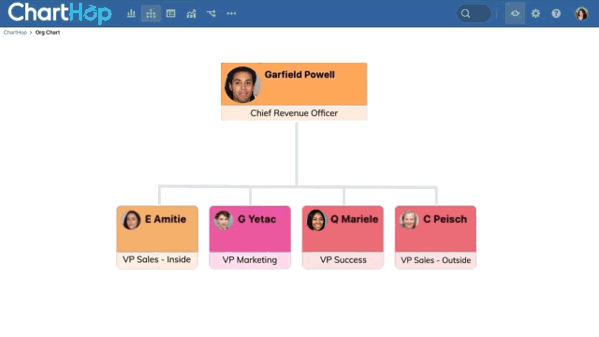
With ChartHop, stakeholders have a reliable resource to centralize communication, discuss changes, and plan out scenarios. Teams no longer have to email changes back and forth to one another, or take time out of their days to meet in-person. A platform like ChartHop allows for cross-functional communication that automatically stores changes in one, secure platform.
With ChartHop, stakeholders can:
- Run scenario plans based on current and historical data to forecast strategically.
- Visualize reporting structure changes, see open roles, and propose new headcount as needed.
- Streamline processes between stakeholders, like headcount approval and budget allocation, to remove bottlenecks and improve alignment.
Between the work ChartHop saved me, and the work it saved our leadership team, we probably saved over $10,000 in lost productivity – in just one headcount planning process.
Colin Bramm, CEO & Co-Founder @ High Growth Startup
ChartHop uncomplicates hiring for everyone. Backed by a single platform for stakeholders to share ideas, give feedback, and approve headcount, teams have everything they need to collaborate effortlessly.
3. Make data-informed hiring decisions
While collecting and centralizing data is important, it’s what you do with that information that really elevates your recruitment strategy to new heights. Data leads to insights, and insights lead to actionable business decisions.
Headcount planning software like ChartHop harnesses the power of reporting to make sense of your people data. Gone are the days of manual spreadsheets with complex models — with ChartHop, you can create your future team and forecast how hiring decisions will impact your bottom line.
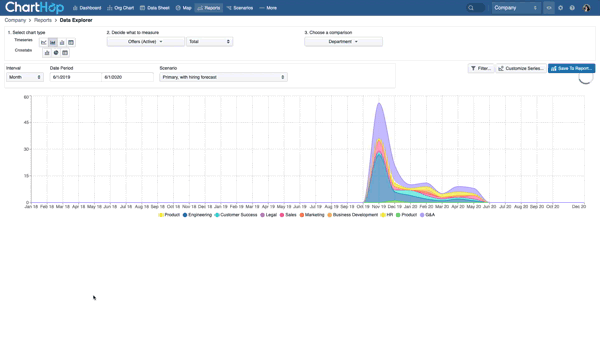
For recruiters and HR teams particularly, ChartHop also makes it easy to track key recruitment metrics. Using customized people analytics and reporting, you can drill down into your current recruitment and onboarding data to optimize future hiring strategies. These people metrics include:
- Time to Fill
- Source of Hire
- Percent of Open Positions
- Promotion and Attrition Rates
- Time to Productivity
When building a recruitment strategy, data should be used to your advantage. With ChartHop, metrics and reporting is made easy, so you can forecast and recruit accordingly.
4. Share headcount plans seamlessly
Planning is only part of the recruitment strategy. In order to meet your hiring goals, you need to execute successfully.
To do so, you need a way to share your hiring plans with everyone. Not just the stakeholders involved in approving headcount, but the entire organization.
Why? Headcount planning affects the business at every level, and everyone has a part in turning these plans into something actionable and concrete.
ChartHop’s technology fuels transparency and accessibility. When your plans are finished, ChartHop enables you to share them across the organization, so everyone can understand where the company is headed and think strategically about next steps. This means:
- Executives can quickly see how departments will be structured and how headcount will contribute to the bottom line. They can also factor in these changes to account for creating the company’s future goals, strategies, and overall mission.
- Hiring managers can see where their teams are headed and collaborate with recruiters to get their hiring needs met. They can also communicate their changes to their teams to prepare them for any upcoming shifts.
- Employees can understand what roles are open/coming down the pike. This could inspire them to tap into their internal networks for employee referrals, or pursue a new opportunity internally.
- Recruiters and HR teams can do their jobs better and faster. When everyone is aligned and plans exist in one, secure place, they can focus on making their recruitment strategy a reality.
When it comes to recruitment, context and clarity are key. The more your organization knows about its hiring plans, the more prepared everyone can be to execute these plans strategically.
Beyond Better Hiring
For your business to scale successfully, you need the right tools and technology to help you hit your hiring goals. Luckily, headcount planning software can help you create a recruitment strategy that’s intuitive, streamlined and backed by data.
But the benefits of headcount planning software go beyond just recruitment. By giving everyone in the business a clear roadmap of the organization and its hiring plans, your people are empowered to thrive. This means they know exactly where they fit in with the organization today, and where the business is headed tomorrow.
Are you ready to take your headcount plans to new heights?




